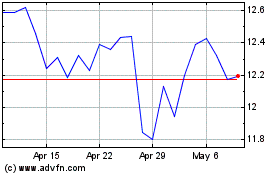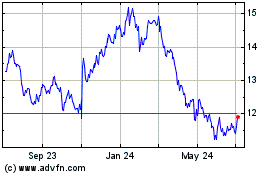KYOCERA Marks 10th Anniversary of "Green Curtains"
August 09 2016 - 8:07AM
Business Wire
Environmental and energy-saving initiative
expands to 27 corporate sites, employee and resident homes
Kyocera Corporation (NYSE:KYO)(TOKYO:6971) announced that it is
planting Green Curtains at its factories and offices in Japan for
the 10th consecutive year as part of its ongoing environmental
protection and sustainability activities. The natural foliage of
climbing plants creates “curtains” that cover building walls and
windows, providing shade for the rooms inside and lowering the
building temperature by up to 2 degrees Celsius*1 (3.6 degrees
Fahrenheit) while helping reduce the use of energy-consuming
air-conditioning systems.
This Smart News Release features multimedia.
View the full release here:
http://www.businesswire.com/news/home/20160809005636/en/
Green Curtains shading the outer walls
(Photo: Business Wire)
One square meter of Green Curtain neutralizes as much as 3.4kg
of CO2 annually. In 2016, Kyocera’s Green Curtains stretched out
for roughly 710 meters and covered an area of 2,900 square meters
in total, absorbing approximately 10,000kg*1 per year. With 10
years of Green Curtain tradition, Kyocera’s efforts total more than
85,000kg of absorbed CO2 — or the equivalent of about 6,300 cedar
trees*2.
Background and expansion to date
Kyocera started growing Green Curtains in 2007 at one of its
factories in Japan’s Nagano Prefecture in cooperation with local
government and a non-governmental organization, with the goal of
further reducing the factory’s environmental impact. To date, the
activities have been expanded to 27 sites in total including
additional factories and offices throughout Japan. Kyocera also
encourages its employees as well as local residents to participate
in this Green Curtain initiative in their own homes by providing
seedlings produced by the Green Curtains. Gourd and morning glory
are the most commonly used plants for the Green Curtains, but many
others such as passion fruit, navy bean, sponge cucumber and mini
Japanese squash (cucurbita pepo) can be used as well.
Enjoy healthy dishes with freshly harvested
vegetables
Kyocera employees enjoy special dishes with vegetables harvested
from the Green Curtains at select company cafeterias or at home.
Gourd is often cooked as tempura with Japanese udon noodles or
onigirazu (Japanese rice sandwich), which has become very popular
in recent years in Japan.
Recipe for Onigirazu (serves 4)
1. Cut gourd in half lengthwise, remove the seeds and cut in
slices. Sauté until wilted with 2 tablespoons olive oil. 2. Lightly
beat 4 eggs, 2 tsp sugar, 1/2 tsp salt and some pepper for
seasoning in a bowl. Make 4 slices of tamagoyaki (Japanese omelet)
with 1 tsp olive oil per 1 slice. 3. Slice Spam (or other meat)
into 4 slices, sauté until lightly browned without oil. 4. In the
center of a piece of plastic wrap, place a large square sheet of
dried seaweed. Layer the following ingredients, in order, from the
bottom up: 1) cooked rice (140g), 2) 1 slice of tamagoyaki, 3)
sautéed gourd, 4) 1 slice of Spam, and 5) cooked rice (140g). 5.
Tightly wrap the filling so that the diagonal corners of the
seaweed meet, cut in half and remove the plastic wrap. *1
CO2 absorption (3.4kg) x area of Green Curtain (m2) = volume
of yearly CO2 absorption. (Source: Rural Culture Association Japan)
*2 One cedar tree absorbs 14kg/year of CO2. (Source: Forestry
Agency of Japan)
To see more images, please
visit:http://global.kyocera.com/news/2016/0804_nfid.htmlFor
more info about Kyocera Green Curtain Activities, please
visit:http://global.kyocera.com/ecology/greencurtains/index.html
About KYOCERA
Kyocera Corporation (NYSE:KYO)(TOKYO:6971)
(http://global.kyocera.com/), the parent and global headquarters of
the Kyocera Group, was founded in 1959 as a producer of fine
ceramics (also known as “advanced ceramics”). By combining these
engineered materials with metals and integrating them with other
technologies, Kyocera has become a leading supplier of electronic
components, printers, copiers, solar power generating systems,
mobile phones, semiconductor packages, cutting tools and industrial
ceramics. During the year ended March 31, 2016, the company’s net
sales totaled 1.48 trillion yen (approx. USD13.1 billion). Kyocera
appears on the 2014 and 2015 listings of the “Top 100 Global
Innovators” by Thomson Reuters, and is ranked #531 on Forbes
magazine’s 2016 “Global 2000” listing of the world’s largest
publicly traded companies.
View source
version on businesswire.com: http://www.businesswire.com/news/home/20160809005636/en/
KYOCERA Corporation (Japan)Tokuko Matsuura,
+81-(0)75-604-3416Corporate
Communicationswebmaster.pressgl@kyocera.jpFax:
+81-(0)75-604-3516
Kyocera (PK) (USOTC:KYOCY)
Historical Stock Chart
From Mar 2024 to Apr 2024

Kyocera (PK) (USOTC:KYOCY)
Historical Stock Chart
From Apr 2023 to Apr 2024
